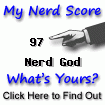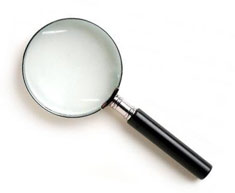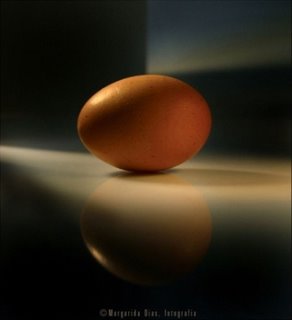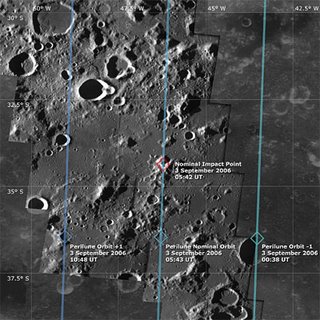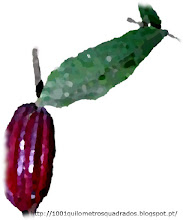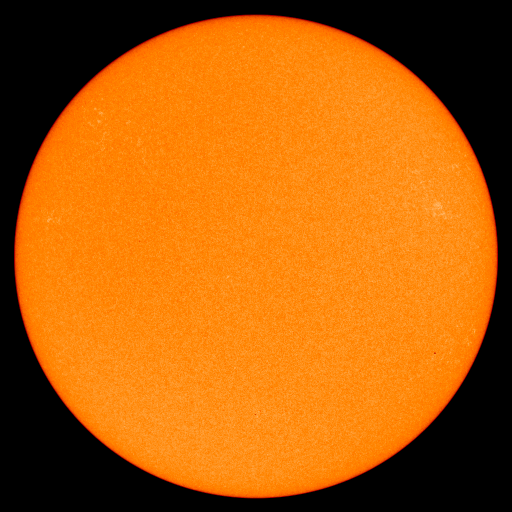10 e 10 não são 20, mas com cinquenta são 11. Como é possível esta soma?
9.15.2006
Enigma 23
Uma questão de contas! Ou como uma senhora da minha terra colocava à prova aqueles que iam escola.
10 e 10 não são 20, mas com cinquenta são 11. Como é possível esta soma?
10 e 10 não são 20, mas com cinquenta são 11. Como é possível esta soma?
9.14.2006
Enigma 22
Enigma 21
 Existem doze moedas de 2 euros aparentemente todas iguais. No entanto, uma delas é falsa, pois tem um peso diferente das outras.
Existem doze moedas de 2 euros aparentemente todas iguais. No entanto, uma delas é falsa, pois tem um peso diferente das outras.Como podemos descobrir qual a moeda falsa utilizando apenas uma balança de dois pratos e três pesagens? E já agora, se é mais pesada ou mais leve que as moedas verdadeiras?
9.13.2006
Sugestão - The most beautiful experiment
 The most beautiful experiment in physics, according to a poll of Physics World readers, is the interference of single electrons in a Young's double slit. Robert P Crease reports.
The most beautiful experiment in physics, according to a poll of Physics World readers, is the interference of single electrons in a Young's double slit. Robert P Crease reports.Top 10 beautiful experiments
1 Young's double-slit experiment applied to the interference of single electrons
2 Galileo's experiment on falling bodies (1600s)
3 Millikan's oil-drop experiment (1910s)
4 Newton's decomposition of sunlight with a prism (1665-1666)
5 Young's light-interference experiment (1801)
6 Cavendish's torsion-bar experiment (1798)
7 Eratosthenes' measurement of the Earth's circumference (3rd century BC)
8 Galileo's experiments with rolling balls down inclined planes (1600s)
9 Rutherford's discovery of the nucleus (1911)
10 Foucault's pendulum (1851)
Enigma 18 e 19
Enigma 17
9.12.2006
Ambiente - Sem comentários
No Público de hoje:
Os efeitos para a saúde dos resíduos tóxicos despejados em lixeiras a céu aberto em Abdijan, que causaram a morte a seis pessoas e deixaram milhares doentes, estão a diminuir à medida que os químicos vão evaporando, garantiu ontem o Ministério da Saúde da Costa do Marfim.
Quase nove mil pessoas procuraram tratamento para aliviar os vómitos, náuseas e dificuldades respiratórias provocadas pelos fumos libertados pelo lixo tóxico, transportado por um barco registado no Panamá e despejado no mês passado em várias lixeiras ao ar livre em redor de Abdijan.
(...)
"Dizem que na origem do problema está o sulfureto de hidrogénio", afirmou à Reuters o porta-voz do Ministério da Saúde, Simeon N"Da. "Felizmente, grande parte já se evaporou, o que significa que os riscos para a população são menores."
O sulfureto de hidrogénio - que cheira a ovos podres, pode ser letal em grandes concentrações. Já em pequenas quantidades é inofensivo, apesar do odor desagradável ainda poder ser detectado. Segundo fontes diplomáticas francesas os resíduos serão recolhidos e armazenados em tanques até serem eliminados.
Os efeitos para a saúde dos resíduos tóxicos despejados em lixeiras a céu aberto em Abdijan, que causaram a morte a seis pessoas e deixaram milhares doentes, estão a diminuir à medida que os químicos vão evaporando, garantiu ontem o Ministério da Saúde da Costa do Marfim.
Quase nove mil pessoas procuraram tratamento para aliviar os vómitos, náuseas e dificuldades respiratórias provocadas pelos fumos libertados pelo lixo tóxico, transportado por um barco registado no Panamá e despejado no mês passado em várias lixeiras ao ar livre em redor de Abdijan.
(...)
"Dizem que na origem do problema está o sulfureto de hidrogénio", afirmou à Reuters o porta-voz do Ministério da Saúde, Simeon N"Da. "Felizmente, grande parte já se evaporou, o que significa que os riscos para a população são menores."
O sulfureto de hidrogénio - que cheira a ovos podres, pode ser letal em grandes concentrações. Já em pequenas quantidades é inofensivo, apesar do odor desagradável ainda poder ser detectado. Segundo fontes diplomáticas francesas os resíduos serão recolhidos e armazenados em tanques até serem eliminados.
9.11.2006
9.10.2006
9.08.2006
9.06.2006
Wikipédia
 Uma enciclopédia de acesso livre, com muita informação disponível (alguma só em inglês), escrita em diversas línguas e feita pelos internautas. Em português já existem mais de 33 mil entradas (Fonte: Wikipédia, a enciclopédia digital feita por voluntários, já tem 33 mil entradas em português), mas cada um de nós na sua especialidade pode, após registo, contribuir para aumentar este número e tornar disponível ainda mais informação.
Uma enciclopédia de acesso livre, com muita informação disponível (alguma só em inglês), escrita em diversas línguas e feita pelos internautas. Em português já existem mais de 33 mil entradas (Fonte: Wikipédia, a enciclopédia digital feita por voluntários, já tem 33 mil entradas em português), mas cada um de nós na sua especialidade pode, após registo, contribuir para aumentar este número e tornar disponível ainda mais informação. Por exemplo, pesquisando aurora polar (a mesma pesquisa em inglês).
9.04.2006
Centro de Fusão Nuclear - IST
 (Clicar na imagem)
(Clicar na imagem)O objectivo principal do Programa de Fusão da "European Atomic Energy Community" (EURATOM) é a descoberta de modelos e o projecto de dispositivos experimentais que possibilitem a construção de reactores de fusão nuclear, controlada, que produzam energia eléctrica a partir de reacções de fusão entre iões de deutério e trítio. Sendo a fusão nuclear o processo de produção de energia mais comum no Universo (ocorre, naturalmente, nas estrelas, nomeadamente, no Sol), espera-se que os reactores baseados neste tipo de reacções possam constituir uma solução para os problemas energéticos do planeta. De facto, estes reactores são ecologicamente bastante mais limpos e seguros que a maior parte das outras formas de produção de energia e utilizarão um combustível virtualmente inesgotável, o hidrogénio, o elemento mais abundante no Universo. (Encontrado no site sugerido)
9.03.2006
9.02.2006
9.01.2006
Sugestão - The Nobel Foundation
 The Nobel Foundation
The Nobel FoundationO local para aprender tudo sobre os prémios atribuídos nas diversas áreas: Física, Química, Paz, Literatura, Economia e Medicina.
Software - Astronomia
 Home Planet
Home PlanetO que o programa permite fazer:
I like to think of Home Planet as putting a somewhat different spin on the Earth and sky. It allows you to view:
- An earth map, showing day and night regions, location of the Moon and current phase, and position of a selected earth satellite. Earth maps can be customised and extended by editing a DLL which provides maps to Home Planet.
- A panel showing detailed position and phase data for the Sun and Moon.
- Panel showing positions of planets and a selected asteroid or comet, both geocentric and from the observer's location.
- A sky map, based on either the Yale Bright Star Catalogue or the 256,000 star SAO catalogue, including rendering of spectral types, planets, earth satellites, asteroids and comets. Celestial coordinates are included, and an extensive and user-extensible deep-sky database includes all Messier objects and many of the NGC objects. Precession and proper motion are accounted for in the display.
- Databases of the orbital elements of 5632 asteroids and principal periodic comets are included, allowing selection of any for tracking. These databases can be user-extended using standard orbital elements. MS-DOS utility programs are included which convert asteroid and comet orbital elements in the form published in Minor Planet Electronic Circulars (MPECs) to the CSV format used by Home Planet. Subscribers to the MPECs can thus easily add newly reported asteroids and comets to the database. Source code for these programs is included.
- A telescope window which can be aimed by clicking in the sky map or telescope itself, by entering coordinates, or by selecting an object in the Object Catalogue (see below). Limiting magnitude, labeling, coordinate display, etc. can be defined by user. Right click on an object to display its entry in the Object Catalogue. Stellar magnitudes can be plotted for stars in a given magnitude range in the telescope window. This makes it easy to create comparison star charts for variable star observing.
- A horizon window which shows the view toward the horizon at any given azimuth. The horizon can be adorned, if you wish, with fractal forged terrain and randomly generated scenery, including houses, livestock, and trees. The scenery is generated by a user-extensible DLL which allows customisation.
- Object Catalogue allows archiving images, sounds, and tabular data about celestial objects. Both new objects and new categories can be added. Bidirectionally linked to the Telescope window.
- Chart catalogues, selectable from within the Object Catalogue, can be plotted in all sky view windows (Sky, Telescope, and Horizon). Objects are specified by right ascension and declination, and can use any of the star, deep-sky, satellite, or user-extensible scenery icons, plus text (in various colours) with user-defined justification. Commands allow plotting straight lines and lines which curve along parallels of latitude. Chart catalogues are included which display chart boundaries and numbers of Sky Atlas 2000.0, and radio sources from the Third Cambridge Survey (3C) cross-identified with the 4C survey.
- Orrery allows viewing the solar system, including a selected asteroid or comet, from any vantage point in space, in a variety of projections.
- Satellite tracking panel. Select an Earth satellite from a database of two-line elements, and see its current position and altitude. Satellite will be shown as an icon on Earth map, Sky, Telescope, and Horizon windows.
- View Earth From panel allows you to view a texture-mapped image of the Earth as seen from the Sun, Moon, a selected Earth satellite, above the observing location, or the antisolar point. For a real thrill, fly Molniya through perigee!
- Satellite database selection allows maintenance of multiple lists of satellites, for example TV broadcast, ham radio, low orbit, etc.
- DDE server permits export of real-time Sun, Earth, and Moon information to any DDE client. A sample Excel worksheet is included.
- Computerised telescope pointing is supported via DDE. When the Telescope window is pointed at a given location in the sky, its coordinates are exported via DDE (in both Right Ascension and Declination and Altitude and Azimuth), permitting a concurrently running telescope drive program to direct a physical telescope to the given location. The sample Excel spreadsheet displays the telescope pointing coordinates.
- Catalogue look-up allows you to right click in any of the sky windows (Sky, Telescope, or Horizon) and locate the closest object in the Object Catalogue. With no keyboard modifier, this searches all eligible catalogues. With SHIFT, CONTROL, or SHIFT+CONTROL, you can direct the search to a specific catalogue. Catalogues are provided which give the chart/plate number for the given location in the following atlases:
SHIFT Sky Atlas 2000.0
CONTROL Uranometria 2000.0
SHIFT+CONTROL Palomar Observatory Sky Survey - Observing site selection lets you choose a site from a database of more than 1300 cities and towns, or by clicking on the world map.
- Animation lets you put the heavens into higher gear, with selectable speed, time direction, and time step. Demonstrate seasonal changes, Moon phases, satellite orbits, precession, proper motion, etc.
- Time and date can be set to any moment from 4713 B.C. into the distant future. Examples of historical research are included.
- Planetary position calculations use the high-precision VSOP87 theory, and lunar position is calculated with the revised ELP-2000/82 lunar theory. Calculation of dynamical time, obliquity of the ecliptic, nutation, precession, and aberration all use high precision algorithms.
- Cuckoo clock. Hey, I live in Switzerland! You can turn it off.
- A comprehensive WinHelp file is included, describing not only the program but the astronomical concepts that underlie it and how to learn more about astronomy.
- Complete program development log included in WinHelp format, accessible from main Help file.
- An optional screen saver that shows the illuminated Earth and position and phase of the Moon is included.
Subscrever:
Mensagens (Atom)

